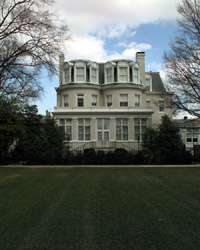George Hadfield (architect)
George Hadfield (1763 – 6 February 1826[1]) was born in Livorno, Italy of English parents, who were hotel-keepers. He studied at the Royal Academy, and worked with James Wyatt for six years before emigrating to the United States. He was also the brother of Maria Cosway, a famous painter who is best noted for her alleged affair with Thomas Jefferson, when he was the Ambassador to France between 1785–1789.
Life and career
He was appointed superintendent of the United States Capitol's construction on 15 October 1795,[2] and continued in that position until June 1798, resigning after an argument with William Thornton.[3][4] He is credited with part of the design of the original Capitol building such as the north wing,[5][6][7] but little of the related papers remain.
He is buried in Congressional Cemetery in Washington, D.C.
List of works
- Original Treasury Department building, drew plans in 1798, completed in 1800; partially destroyed by fire in 1801 and burned by British forces in 1814[8][9]
- Navy Department, 1800[10]
- Washington Jail, 1801, later converted to a hospital, burned in 1861[11][12]
- Marine Corps Commandant's House, 1801–1805[13][14]
- Arlington House (Custis-Lee Mansion), 1818[15][16][17]
- District of Columbia City Hall, 1820[18][19][20]
- Van Ness Mausoleum[21]
Possible works
- Historic Huntley[22]
Other
There are other works. However they are not easily identified, since they are not in the Greek Revival style. For example, Hadfield is credited with alterations to The Octagon House.[23]
Gallery
- District of Columbia City Hall
 Van Ness Mausoleum
Van Ness Mausoleum- Front view of Arlington House
 Commandant of the Marine Corps' house at 8th & I SE
Commandant of the Marine Corps' house at 8th & I SE_(Harper's_engraving).png) Original U.S. Treasury building.
Original U.S. Treasury building.
See also
- Étienne Sulpice Hallet
- James Hoban
- Benjamin Latrobe
Notes
- "Interments in the Congressional Cemetery" (PDF). 17 July 2001. Archived from the original (PDF) on 18 December 2004. Retrieved 14 January 2008.
- Scott, Pamela (20 March 1995). "'Temple of Liberty' Building a Capitol for a New Nation". The Library of Congress. Retrieved 15 January 2008.
- Tatman.
- Bryan, pp 314–315, states that it was 28 May 1798, and that Hadfield said he had not been paid for plans for the state and war office buildings.
- Dunlap, page 336.
- Bryan, pages 315–318. Bryan gives some of the background, noting that until Hadfield's discharge, all of the detailed working drawings were done by Hallett or Hadfield, and that Thornton started to produce detailed drawings after this point after failing to obtain them from Hallett.
- "The Temple of Justice and Faith: The Capitol's East and West Porticoes and Dome". The Library of Congress. Retrieved 18 January 2008.
Two of the pictures here are said to be based on Hadfield's designs. - "Fact Sheets: U. S. Treasury Building". United States Department of the Treasury. 17 October 2007. Archived from the original on 9 January 2008. Retrieved 15 January 2008.
- William W. Warner, At Peace with All Their Neighbors: Catholics and Catholicism in the Nation's Capital, 1787-1860 (Georgetown University Press), pp. 126-27.
- Historical marker for the Old Executive Office Building which replaced this in 1871 says it was designed in 1797, and that James Hoban designed the War Department.
- "Washington Jail Site, Location: Fourth and G streets, NW". Cultural Tourism, DC. Archived from the original on 8 June 2007. Retrieved 15 January 2008.
- Bednar, Michael J. (2006). "L'Enfant's Legacy: Public Open Spaces in Washington, D.C." The Johns Hopkins University Press: 122. ISBN 0-8018-8318-0. Retrieved 19 January 2008. Cite journal requires
|journal=(help)
According to Bednar, the jail was built in 1802, a two-story brick building, which was used for the Washington Infirmary Hospital after 1853, until it burned in 1861. - "Marine Corps Commandant's House". Cultural Tourism, DC. Archived from the original on 9 October 2007. Retrieved 15 January 2008.
- "The National Museum of the Marine Corps and Heritage Center". 2006. Archived from the original on 5 November 2009.
- "Arlington House Architecture & Construction". U. S. National Park Service. 24 March 2002. Archived from the original on 10 January 2008. Retrieved 14 January 2008.
- "National Register of Historic Places Nomination Form: Arlington House" (PDF). 15 October 1966. Retrieved 16 January 2008.
- Moeller, page 337.
- Gutheim, page 45.
- "History of Judiciary Square". District of Columbia Courts. Retrieved 18 January 2008.
- "History of the E. Barrett Prettyman Federal Courthouse". United States District Court for the District of Columbia. Archived from the original on 12 February 2008. Retrieved 18 January 2008.
- Ridgely, Helen West (1908). "Historic Graves of Maryland and the District of Columbia". The Grafton press: 248. Retrieved 16 January 2008.
van ness mausoleum.
Cite journal requires|journal=(help) - See historical marker.
- Moeller, pages 176–177.
References
- Bryan, Wilhelmus Bogart (1914). "A History of the National Capital". The Macmillan company: 259. Retrieved 17 January 2008.
hadfield north wing capitol.
Cite journal requires|journal=(help) - Dunlap, William (1834). "History of the Rise and Progress of the Arts of Design in the United States". George P. Scott and Co., Printers: 336. Retrieved 16 January 2008.
van ness mausoleum.
Cite journal requires|journal=(help) - Gutheim, Frederick Albert; Lee, Antoinette J (2006). "Worthy of the Nation: Washington, DC, from L'Enfant to the National Capital Planning Commission". The Johns Hopkins University Press. ISBN 0-8018-8328-8. Retrieved 18 January 2008. Cite journal requires
|journal=(help) - Moeller, Gerard Martin (24 October 2006). AIA Guide to the Architecture of Washington, D.C.. JHU Press. pp. 176. ISBN 978-0-8018-8468-9. Retrieved 16 January 2008.
george hadfield's city hall.
- Tatman, Sandra L. "Biography from the American Architects and Buildings database – Hadfield, George (1763–1826)". Philadelphia Architects and Buildings. Retrieved 15 January 2008.